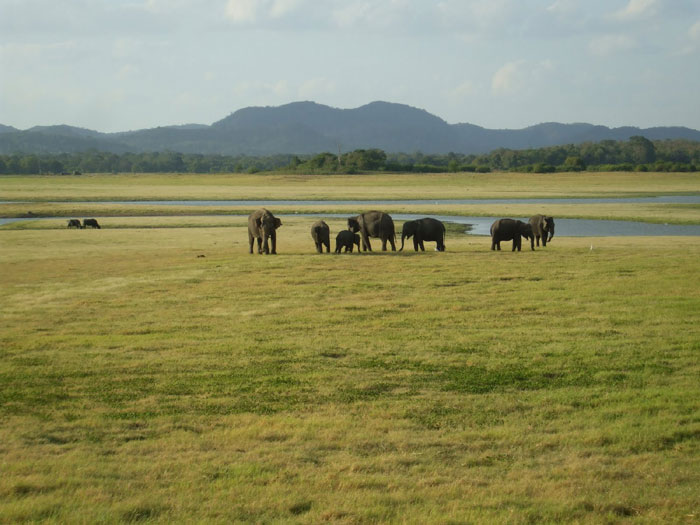 |
Home About Directory Conservation |
 |
Reservoirs of Maduru Oya National Park Location: 70 40’ 0 N and 810 0’ 0 E to 70 25’ 0 N and 810 15’ 0 E; 847448 N and 500000 E to 819818 N and 527588 E; spanning the Districts of Ampara, Badulla and Polonnaruwa in the Eastern, Uva and North-central Provinces. Area: The park is 58,850 ha in extent of which the wetlands constitute around 10,000 ha. Altitude: The major portion of the park lies between 30 – 150 m, while the maximum altitude is 685 m. Overview: The wetlands within Maduru Oya National Park constitute the immediate catchments of five reservoirs developed under the Accelerated Mahaweli Development Programme. The water bodies include the Maduru Oya (6,100 ha), Ulhitiya (2,270), Ratkinda (1,100 ha), Kadupaharaella (700 ha), and Henanigala (800 ha) reservoirs and tributaries of the Mahaweli and Maduru Oya river systems. The park provides a refuge for elephants and a large number of water birds. Fishing with permits is allowed in the reservoirs. The area is scattered with archaeologically significant sites. Physical features: The dominant topographic feature of the area is the 8 km long stretch of rocky mountains in the southwest of the park. The geological regime comprises alluvium deposits and Miocene limestone. Red earth that is relatively fertile but easily eroded, is the predominant soil type. Lying within the dry zone of the country, the climatic conditions are largely influenced b the northeast monsoon, which lasts from October to February. The mean annual rainfall is 1,650 mm and the mean annual temperature is about 270C. Overall, the annual evapotranspiration rates normally exceed precipitation levels. Ecological features: The surrounding area consists of scrubland and tropical dry mixed evergreen forest growing between the prominent rock outcrops. Characteristic floral species include Drypetes sepiaria, Chloroxylon switenia, Manilkara hexandra and Pterospermum canescens. To the west and north of the park is the Mahaweli development area (System B) where paddy cultivation and homesteads are prominent. To the east of the park there is a teak plantation and scrub jungle. Noteworthy fauna: The freshwater fish in the reservoirs are dominated by exotic species such as Oreochromis mossambicus and Osphronemus goramy. Aquatic reptiles associated with the reservoirs include Crocodylus palustris, Melanochelys trijuga and Lissemys punctata. The reservoirs harbour several species of water birds, including large flocks of cormorants (Phalacrocorax spp.), Anhinga melanogaster, Pelecanus philippensis, Anastomus oscitans, Mycteria leucocephala, Threskiornis melanocephalus and Platalea leucorodia. The mammals that frequently visit the reservoirs include Elephas maximus, Canis aureus, Prionailurus viverrinus, Lutra lutra, Cervus axis and Sus scrofa. Noteworthy flora: Vatica obscura (rare and endemic) is the only species of the Dipterocarpaceae to occur in the dry zone and is found in restricted locations on the banks of the Maduru Oya. Other woody species around the reservoirs include Drypetes seperia, Chloroxylon sweitenia, Manilkara hexandra, Diospyros ebenum, Trema orientale, Zizyphus oenoplea, Pterospermum canescens, Feronia limonia, Cassia fistula, Dimophocalyx glabellus, Vitex altissima and Sterculia foetida. Land use: The land is mainly used for biodiversity and catchment conservation, while some areas have been encroached by people to establish chena cultivation areas. Fishing, which is under license from the DFAR is carried out in the reservoirs. Local people also collect medicinal plants and herbs from within the park area. Possible changes in land use: Increased deforestation by chena cultivators and encroachment of the wetland area by local villagers are possible along with an increase in fishing effort. Hydrological and biophysical values: The reservoirs play an important role in storing water during the dry seasons and in irrigating large areas of agricultural land and are also useful for flood prevention during the rainy seasons. Social and cultural values: Ruins found at Henanigala, Kudawila, Gurukumbura, Ulukentangoda, Werapokuna and several other places include ancient Buddhist shrines, temples, dagobas, statues and hermitages from different eras in Sri Lanka’s history. An ancient sluice more than 9 centuries old has been found on the old breached earthern bund of the Maduru Oya, while early Brahmin inscriptions from the 1st to the 3rd centuries have been discovered at Kandegamakanda. A community of Veddas, the adivasi people of Sri Lanka, live within the park boundary in Henanigala Scientific research and monitoring: The Open University of Sri Lanka and the Eastern University have conducted studies on the biodiversity of the National Park. Accommodation and research facilities are available at Kandeganwila. Conservation education: A wildlife museum and visitor centre is located at the park entrance. Recreation and tourism: The park is popular among nature lovers, especially for viewing elephants and birds. Visitor accommodation in the form of two circuit bungalows, a dormitory and a campsite are available within the park. Conservation measures taken: In 1983, 51,468 ha of land acquired from the crown lands through the Mahaweli Authority Act was declared as a National Park under the FFPO. In 1985 the park area was extended to 58,850 ha, in order to provide additional habitat for wildlife and to ensure protection of important catchment areas. In the same year, a 157 draft management plan was prepared under the USAID funded Mahaweli Environment Project and subsequently revised in 1987. Conservation measures proposed: Linking the Maduru Oya National Park with the Gal Oya National Park via the Nilgala jungle corridor has been proposed to provide a more continuous habitat for wildlife. Disturbance and threats: Large areas of forest within the park have been exploited for chena cultivation, and much of the park now consists of secondary growth and open grassland. Encroachment of the wetland area, poaching and illegal timber felling are serious problems within the park. The park has also been invaded by the alien species Lantana camara, while the Maduru Oya reservoir has been infested with the exotic floating weed Salvinia molesta. Land tenure: State owned Management authority and jurisdication: The National Park is under the jurisdiction of the DWC, while the reservoirs and irrigation canals are managed by the MASL. References: DWC (2004); Kotagama et al. (1989); MEP/DWLC (1987) |
| Maps |